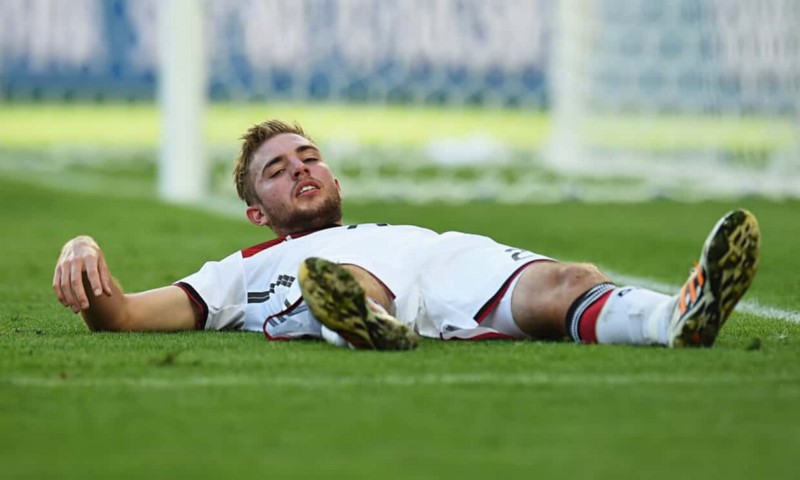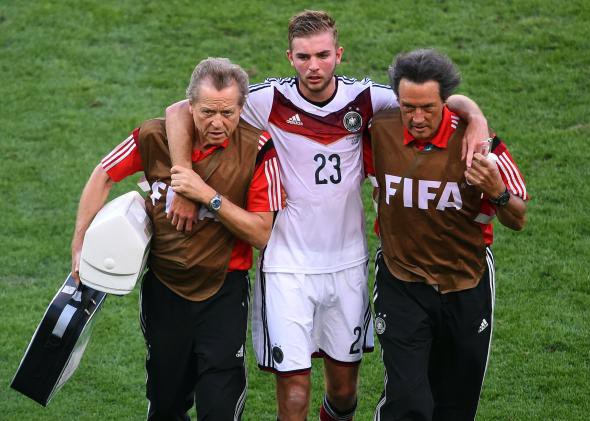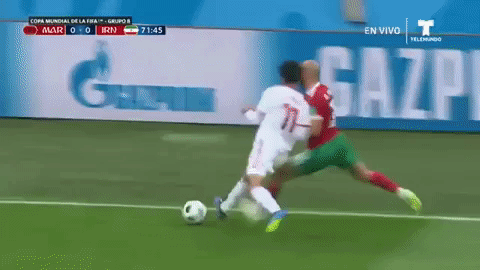The scene was Maracana stadium in Rio De Janeiro, and the stage was set for Germany to play Argentina in the World Cup Final. Hundreds of millions of people had tuned-in for the world’s biggest sporting event — except of course for local Brazilians in favelas who can’t afford television sets but “hey, let’s ‘invest’ and subsidize the construction of 12 stadiums, most never to be used again!”.
17 minutes into the match, Germany’s Christoph Kramer took an elbow to the head, courtesy of Argentinean defender Ezequiel Garay.



He was allowed back into the game after a cursory check, had a conversation with referee Nicola Rizzoli about what game he was playing in (because it’s really important to know that), and 14 minutes later, fell to the pitch, dazed and confused. He was then finally escorted back to the locker room and told that he was being treated for a concussion.



Christoph Kramer, by his own admission, remembers none of this. He knows Germany won but he doesn’t remember the match. So why was he allowed back into the game without an evaluation and then allowed to play for another 14 minutes with all these warning signs?
That incident took place in 2014. The problem is, nothing’s changed since.
To their (limited) credit, after the incident with Christoph Kramer (more like, the bad publicity from the incident with Kramer) and a study of 2014 World Cup concussions that examined video footage of all 64 matches and found that medical staff examined players for concussion in only 15% of potential head injury or concussion incidents, FIFA did implement a new protocol for head injuries and concussion protocol. It includes the following:
- A new education program for team doctors, coaches, referees, officials and players
- Giving the referee the ability to stop the match if a head injury is suspected
- A 3-minute, maximum, stoppage for medical staff to complete an on-pitch assessment
- The referee will only allow the player to continue if the team doctor, who has the final decision, gives authorization
- Additionally, in February 2018, FIFA implemented in-game video review of concussion/TBI incidents where a member of the medical staff could assist the primary Doctor in diagnosis via video review
With all these fancy new rules, the 2018 World Cup would be proof of just how far FIFA had come. There’s no way lax concussion testing and a complete disregard of the shiny new FIFA protocol would be tolerated, right?
I think you know what comes next after that type of leading question.
World Cup 2018 Concussion Incidents
There were 4 incidents this World Cup (and many more that I’m sure we will hear about down the line) that jumped out to me as just blatant mishandling and breaking of FIFA’s new protocols.
1 — Iceland centerback Ragnard Sigurdsson was kneed in the back of the head in the 49th minute of Iceland’s 2–0 loss to Nigeria, immediately clutching the back of his head while writhing around on the ground.
He stood up with the help of the medical staff, had his head bandaged, went off the field for a minute, and then returned. No concussion evaluation was performed and he was subbed out 16 minutes later.
Here’s a video of the incident and the exact timeline:
Newest #WorldCup #Concussion Watch:
48:24 #Iceland's Ragnar Sigurdsson hit, stays down
49:40 Medics arrive
52:34 Stands
53:41 Returns w/head bandage & no concussion eval
65:00 Subbed outIf diagnosed post-match, this is another #FIFA protocol failure.
cc @FIFPro pic.twitter.com/syYUbj52KW— Chris Nowinski, Ph.D. (@ChrisNowinski1) June 22, 2018
2 — Peru centerback Renato Tapia was knocked to the ground after colliding with Denmark’s Simon Kjaer during Group C match play. Here’s the incident at hand:
More concerning #WorldCup2018 #concussion care today!
Peru's Renato Tapia is not moving when the referee arrives after a severe body-to-head impact, yet is not evaluated, & returns. When he finally stands up, FS1 commentator says, "It looks like he's fine." Watch the video: pic.twitter.com/ix8fX64ISQ
— Chris Nowinski, Ph.D. (@ChrisNowinski1) June 16, 2018
Peru then implemented the heavily researched “squirt water on the head and pat on the butt” concussion protocol:
FIFA #concussion protocol in spotlight late in today's Denmark-Peru World Cup match. Peru's Renato Tapia left the field after taking heavy hit to the head. As a trainer doused Tapia's head with water, FS1 announcer said, "Cold water is not enough, my friend." pic.twitter.com/XN2TCdt3gG
— Dr. Javier Cardenas (@theconcussiondr) June 16, 2018
3 —French midfielder Blaise Matuidi’s face collided with Eden Hazard’s arm and elbow during France’s semifinals against Belgium. Here’s the collision:
This player was sent back onto a World Cup field after a <2-minute evaluation:https://t.co/dkWtT7olxt pic.twitter.com/cA3wveiCGB
— Henry Bushnell (@HenryBushnell) July 10, 2018
He was tended to by his teammates, taken to the sidelines up by the medical staff, and allowed back into the game after fifteen seconds.
FIFTEEN seconds. That sideline must be part of Gohan and Goku’s time-slowing hyperbolic time chamber.
2 minutes later, Matuidi collapsed to the ground, and was subbed off:
#FIFA #WorldCup2018 @ConcussionLF #concussion alert:
France's Blaise Matuidi was involved in a collision & taken to the sideline. Docs evaluated him for a whole 2 minutes before clearing him to return.
He lasted less than 2 minutes before collapsing.
I'm very tired of this. pic.twitter.com/Bw8sn8etTs
— Chris Nowinski, Ph.D. (@ChrisNowinski1) July 10, 2018
Matuidi’s face sums up my reaction to this entire sequence:
Blaise Matuidi does not look OK. pic.twitter.com/19OoD8WY6y
— Jeff Eisenband (@JeffEisenband) July 10, 2018
4 — The fourth example is last but certainly not least. It’s the most egregious and sums up the ineptitude of all parties involved.
Morocco’s winger Nordin Amrabat was involved in a collision and after hitting the ground exhibited a stiffened posture known as the “fencing response” (for more on that, I wrote about it here).
Here’s the incident:



The fencing response is highly indicative of concussion. So no doubt he was evaluated for one right…instead, Morocco chose to implement their highly valid “few slaps on the face while teammate squirts water on the head as player stumbles around” protocol:



He then spent the night in the hospital and here’s what he said about his memory of the match and incident:
“I can’t remember anything from it (the first concussion and match). I can’t even remember the beginning of the game before the incident. From the first minutes of the match until I woke up in the hospital five or six hours later.”
He was confirmed to have suffered a concussion at the hospital (never evaluated on the field) and put into the concussion protocol. FIFA protocol states that he should be out for at least 6 days before return to play.
He played 5 days later against Portugal.
Football has its head up its ass.
Nordin Amrabat is playing for Morocco despite being concussed at the weekend, spending a night in hospital, and the Moroccan FA saying he’d be out for at least a week.
A padded cap does NOT protect from #concussion. #WorldCup pic.twitter.com/qd3ibrrs99
— Andy McGeady (@andymcgeady) June 20, 2018
So you have the Moroccan national team and medical staff breaking protocol both on and off the field. At this point, FIFA must be at the village blacksmith sharpening their blades, +10 to incisive “WTF ARE YOU DOING MOROCCO” damage.
FIFA’s heart-chilling response
Turns out FIFA was just sharpening their pencil. FIFA’s medical chief WROTE A LETTER to the Moroccan team doctor to remind him of the rules. That’s it.
Here’s how Nordin Amrabat (sponsored by WebMD) responded when he heard about the letter afterwards:
“A week is the official time you should recover for to make sure that you are safe but I decided to make it shorter. I Googled the consequences that concussion can have on someone and I thought I can do it, I can play.”
I don’t understand why FIFA got involved. They sent a letter to our doctor regarding the procedure after a concussion and the treatment he gave me on the pitch. I am my own doctor and hopefully nothing will happen to me in the long term.”
And his coach Harve Renard when asked why Amrabat was allowed to play:
“He is a warrior. He wanted to play.”
Shades of Kellen Winslow Jr.
And when Renard was asked why Amrabat took off his head protector 13 minutes into the match:
“Because his spirit was amazing.”
They really took that letter to heart.
What FIFA doesn’t realize is that their impotent response undermines not only the actual protocol but it further reinforces the lackadaisical attitudes toward brain injury and player safety. It’s basic human operant conditioning at play.
Rewards and punishments dictate future actions. Disproportionate rewards and punishments exponentially dictate future actions.
If a kid isn’t reprimanded, he (or she) will very likely continue to do what he’s doing. If that kid is given a very light slap on the wrist for a severe infraction, he’s not only gonna keep doing it but he’s now emboldened to disregard the rules even more because, in his mind, the authority figure is castrated.
That’s where FIFA is at with the Moroccan national team. So what exactly can FIFA do to reign it all in? The first avenue is obvious…
Enforce the Existing Rules
The first step for FIFA is pretty simple: stringently enforce the current rules. They took some good steps after the 2014 World Cup with the new rules but without enforcing them, you might as well not have any.
These scathing quotes from Players Football Association (PFA) chairman Ben Purkiss sum it up nicely:
“You can have the best drafted, shiniest rule book on the table but if you don’t apply it, what’s the point? There’s no point whatsoever. You can say you’ve looked into it and we’ve done this, that and the other. It’s about how things are applied in practice.
“Whenever you ask players how they are, their instant reaction is ‘I’m fine’ because they don’t want to be accused of not going through a brick wall for the cause. That’s why it’s crucial the protocols are in place and the decision has to be taken out of the hands of both players and managers.”
There have to be consistent and serious consequences or we’ll continue to see the same type of disregard for FIFA concussion protocols. After all, in the words of George RR Martin “words are wind”. (George, if you’re reading this, DM me with a Winds of Winter sneak preview).
Additionally, FIFA needs to work towards improving the current rules changing unrealistic parameters and filling gaping holes. These include…
Increasing the time limit for evaluation
Right now a team’s medical staff is allotted 3 minutes to examine a player for a concussion. However, a reliable and valid concussion evaluation can take 10 minutes, on average.
Even if the medical staff chooses to assess a player (which we’ve seen isn’t the case more often than not), the 3-minute rule limits the accuracy of evaluations. Therefore, the time limit needs to be increased to 10 minutes to allow for proper assessment.
To account for this longer period of time off the pitch and maintain competitive balance, new substitution rules need to be implemented…
Substitution rules
1 — Temporary sub
If a player is suspected of having a concussion and taken off the pitch for 10 minutes to be evaluated, a replacement player would be allowed on in the interim.
2 — Extra sub
If that potentially concussed player is confirmed to have a concussion then the temporary sub becomes a permanent sub. Additionally, an extra sub is allotted to make up for that sub. Currently, FIFA allows for an extra sub if the game goes into extra time.
English Premier League doctors are completely on board with these changes and have vehemently been asking for increasing the time limit to 10 minutes and implementing the temporary + extra sub rule.
Further, to bolster medical decision & decrease medical bias, FIFA needs to mandate…
D. Independent doctors
In an ideal world, the team medical staff would make decisions based on player safety and player safety alone, with no weight given to the team circumstances or gravity of the match. They would err on the side of caution with all players.
However, that’s clearly not the reality. Team medical staff know how much rests on the outcomes of these games and further know they will could face the wraith of the coach, team, fans, federation, and even the player themselves if they mistakenly pull a player out and things don’t go well.
For example, the Moroccan national team doctor admitted to FIFA medical chief Michael D’Hooghe that it was wrong to allow Moroccan player Nordin Amrabat back onto the field after only five days but he felt pressure to clear him.
These factors bias medical decision making, especially when you don’t have enough time to complete an accurate diagnostic in the first place. Medical staff are still human after all.
For these reasons, an independent doctor who isn’t associated with the team or team outcomes needs to be making the final call.
There’s one more important rule left…
E. Expanding Video Review
As I briefly touched on earlier, FIFA recently allowed for a second member of the medical staff to review a replay of the possible concussion incidents and help the on-pitch doctor with their diagnosis.
However, that scope for video review is far too limited. It’s only used if an evaluation has already been triggered. The video review can be expanded for medical staff on the sidelines or in the stands to review incidents with video playback, such as with tablets, that they initially missed. The technology is called myplayXplay.
Behind the scenes: Trialling new head injury assessment technology at #WorldRugbyU20s with #myplayXplay. pic.twitter.com/CpeWRH6TNi
— World Rugby (@WorldRugby) June 22, 2016
The English Premier league has allowed this since 2016 and UEFA is highly considering it after the Loris Karius debacle. Being part of a professional medical staff isn’t an easy job, let’s give as many tools as possible to help.
The overall point of all these changes is, first and foremost, to increase player safety. Secondly, these changes would decrease the pressure on medical staffs to rush to judgement regarding a concussion diagnosis while decreasing the pressure on players, especially goalkeepers, to stay in the game after a head injury.
Dr. Willie Stewart, a British neurosurgeon who has been a champion for improving head injury assessment in soccer and rugby, summed it all up when he told BBC Sport:
“Football doesn’t allow an interchange for a player to be assessed to see if he has a brain injury; doesn’t allow significant time for the medics to assess the player; doesn’t have a video review of events to be able to say if there was a glancing blow on my goalkeeper’s head which I didn’t notice. It’s unacceptable in 2018 that it should be this way.”
So Will FIFA Actually Make These Changes?
Other than the potential for an increased video review, early returns on the World Cup 2018 concussion debacle aren’t promising.
FIFA medical chief Michael D’Hooghe has wavered on imposing stricter sanctions against teams and medical staffs who break protocol.
He hinted at possible penalties and sanctions, saying:
“We thought that with these guidelines we had enough power, but it seems now that this is not the case. Perhaps we need to go one step further and impose sanctions if the guidelines are not followed.”
But then he also said that further punishment would be:
“An attack on the medical freedom of the team doctor…I cannot do that.”
My default with FIFA is always this: nothing is going to change until it affects their money or reputation. Sepp Blatter being president for as long as he was is case in point.
Further, in regard regards to on-field rule changes, FIFA is not considering changing time limits or new substitution rules, as told again by FIFA’s medical chief Michel D’Hooghe to the Telegraph:
“I am not in favour of temporary substitutions, for many reasons.”
He went on to imply that teams may abuse and exploit the rules for tactical gain, and then poo poo’d the idea of longer evaluations with hyperbole while also admitting the current time limit doesn’t allow for a complete evaluation:
“Of course, this is not enough for a complete neurological examination, but we cannot ask the referee to stop the game for 35 minutes.”
FIFA’s hardline stance of “no” is also evident for replacing national and team affiliated medical doctors with independent team doctors. Michael D’Hooge has again rejected that change because he believes familiarity with the players outweighs the need for neutrality:
“Otherwise, you would have to work with absolutely neutral doctors, and that is also not the ideal situation.”
It’s not?
I understand the reservations and the point he’s going for when it comes to national and team doctors being more familiar with players (and thus their injury histories) but a reliable concussion test needs as many objective factors as possible. This sounds like another excuse for FIFA to avoid conflict rather than make the responsible decision.
For anyone who has followed soccer’s governing body at all, you already know they are going to hold out against rule changes for as long as possible. The lack of change or willingness to change is no surprise.
FIFA is last at nearly everything else so why wouldn’t the same apply here. I wonder if they use James Franco’s track 1–2–3 rationalization from Freaks and Geeks.
My only hope is that progressive leagues like the English Premier League have enough influence to pull larger organizations like UEFA into the future which then puts the pressure on FIFA to do the same. Hopefully, this happens before a player gets critically hurt which leads to FIFA scrambling around reactively and giving press conferences on how much they care about player safety as exhibited by new rules to make sure it never happens again.
There was a time not too long ago when changes like goal-line technology and VAR were also looked upon with doubt yet 99.3% of VAR decisions were made correctly at World Cup 2018(a number bested only by Putin’s voter share in the Russian elections). We have to harness change rather than resist it, especially when player safety and health are on the line.
However, history shows that FIFA changes at a snail’s pace…but is that acceptable when a player’s health is at risk? How long are we willing to wait for change when it comes to an injury like the concussion that affects our most vital organ, can easily go unseen, and can lead to devastating short, medium and long-term effects if not treated immediately & effectively?
It’s clear the current FIFA protocols and lack of teeth aren’t just not working, they’re actually emboldening teams to get away with more. It’s our responsibility to raise the awareness about this issue and protect the players, even if the governing body and national teams won’t.













